
“You always pass failure on the way to success.”
– Mickey Rooney
Jobs Update
- Initial jobless claims for the week ending April 30th, 2022 came in at 200,000, up 19,000 people week-over-week.
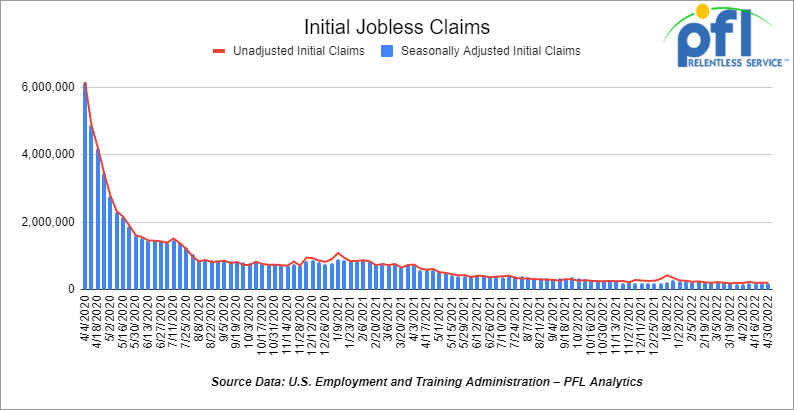
- Continuing claims came in at 1.384 million people, versus the adjusted number of 1.403 million people from the week prior, down -19,000 people week-over-week.
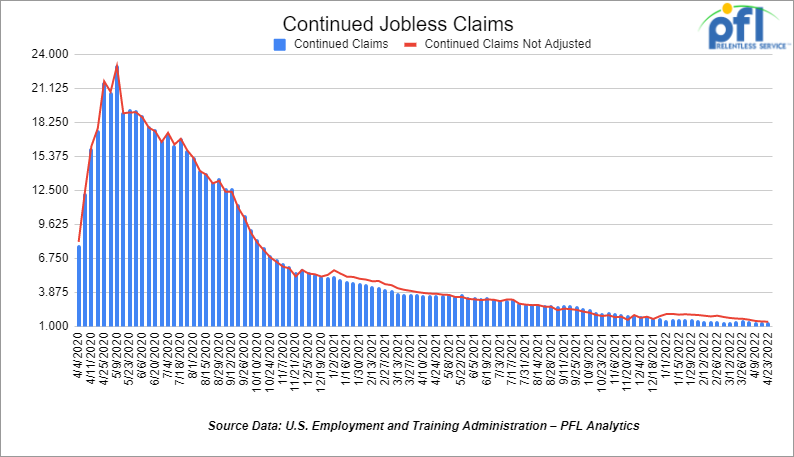
Stocks were lower on Friday of last week and down week-over-week
The DOW closed lower on Friday of last week, down -98.60 points (-0.30%), closing out the week at 32,899.37 points, down -77.84 points week-over-week. The S&P 500 closed lower on Friday of last week, down -23.53 points, and closed out the week at 4,123.34, down -8.59 points week-over-week. The Nasdaq closed lower on Friday of last week, down -173.03 points (-1.4%), and closed out the week at 12,144.66, down -189.98 points week-over-week.
In overnight trading, DOW futures traded lower and are expected to open at 32,286 this morning down -523 points.
Oil closed higher on Friday of last week and higher week over week
Oil prices rose again on Friday of last week, closing out the week with the second straight week over week gain. Investors are expecting higher U.S. demand as the Biden Administration announced plans to replenish the strategic petroleum reserves. In addition, OPEC+ announced a modest production hike yesterday, however, actual production will fall short of their target quota. Certain member nations are having production challenges and will never be able to reach their targets. WTI traded up $1.51 or 1.39% to close at $109.77 per barrel. Brent traded up $2.15 or 1.94% to close at $113.05 per barrel.
Where oil prices will go is anyone’s bet, here are a few things out there worthy of mentioning:
- U.S. Senate Committee Passed NOPEC Bill last week. A U.S. Senate committee passed the NOPEC Bill that was presented with bipartisan support, potentially revoking the sovereign immunity protecting OPEC+ countries from lawsuits, as high gasoline prices and overall energy pricing fueling inflation compelled U.S. lawmakers to take more aggressive action.
- Will Europe ban Russian oil – Despite Germany coming to embrace a Russian oil embargo, the European Union has still been unable to agree on a phase-out of Russian crude imports as most dependent countries like Hungary or Slovakia keep on asking for exemptions.
U.S. commercial crude oil inventories (excluding those in the Strategic Petroleum Reserve) increased by 1.3 million barrels week-over-week. At 415.7 million barrels, U.S. crude oil inventories are 15% below the five-year average for this time of year.

Total motor gasoline inventories decreased by 2.2 million barrels week over week and are 4% below the five-year average for this time of year.
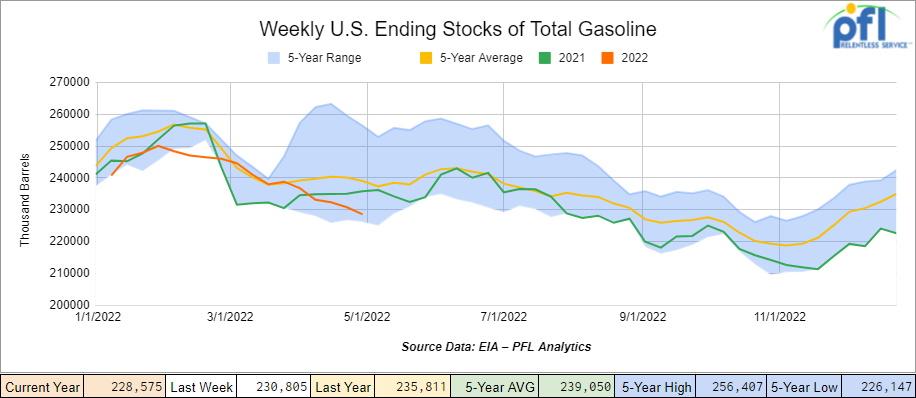
Distillate fuel inventories decreased by 2.3 million barrels week over week and are 22% below the five-year average for this time of year.
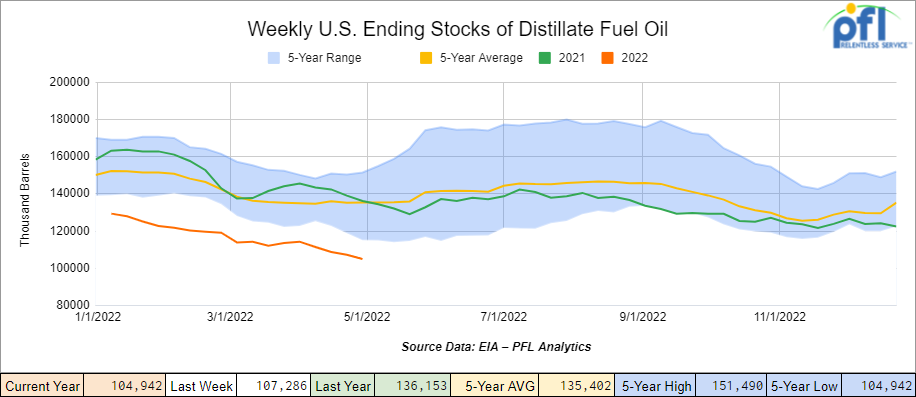
Propane/propylene inventories increased by 1.6 million barrels week over week and are 11% below the five-year average for this time of year.
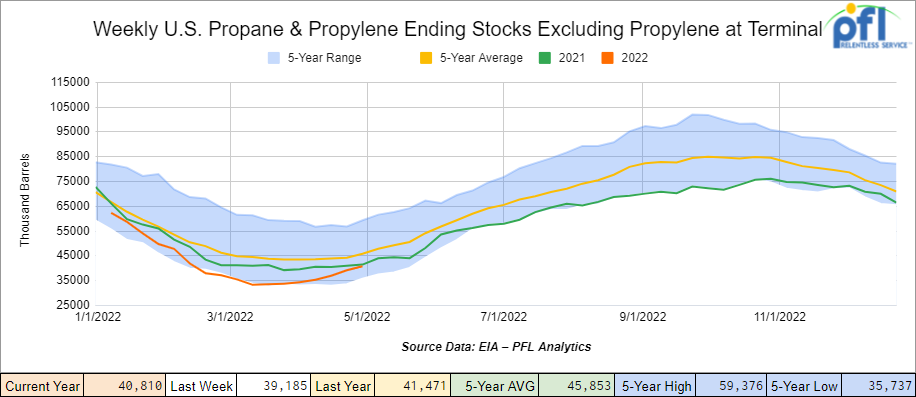
Propane prices were down three cents week over week closing out the week at $1.28 per gallon but were up 45 cents year over year. The five-year average for propane prices is 66 cents per gallon.

Overall, total commercial petroleum inventories increased by 2.6 million barrels for the week ending April 29, 2022.
U.S. crude oil imports averaged 6.3 million barrels per day during the week ending April 29th, 2022, up by 397,000 barrels per day week over week. Over the past four weeks, crude oil imports averaged 6.0 million barrels per day, 3.3% more than the same four-week period last year. Total motor gasoline imports (including both finished gasoline and gasoline blending components) averaged 1.1 million barrels per day, and distillate fuel imports averaged 91,000 barrels per day for the week ending April 29, 2022.
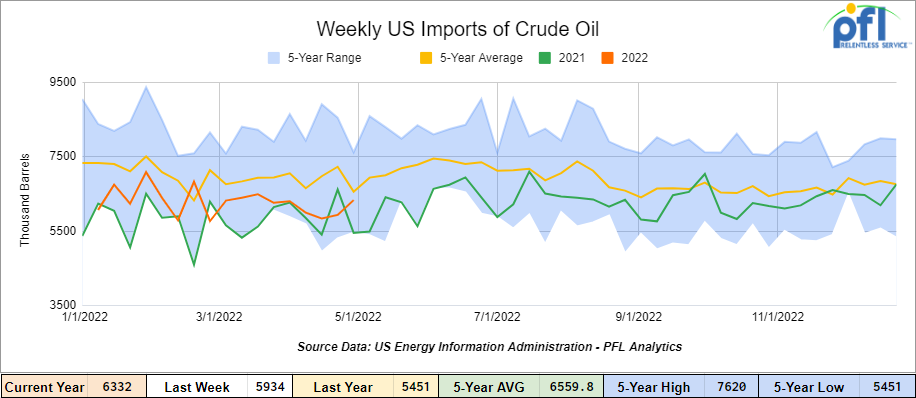
U.S. crude oil refinery inputs averaged 15.5 million barrels per day during the week ending April 29, 2022,which was 218,000 barrels less per day week over week.
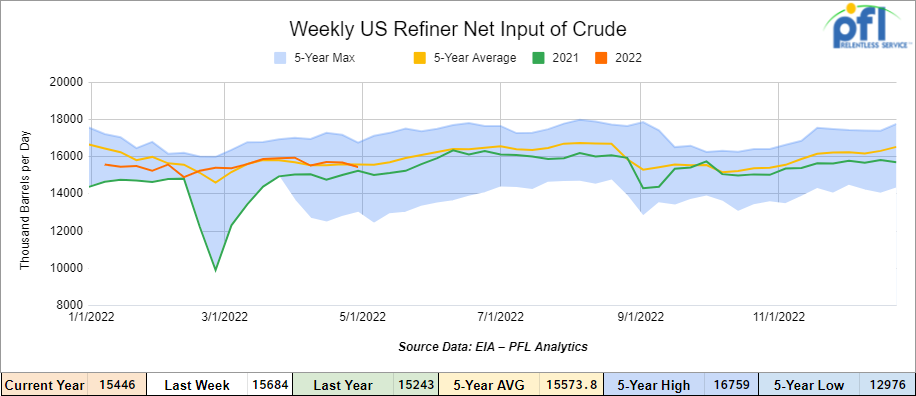
As of the writing of this report, WTI is poised to open at $107.18, down -$2.59 per barrel from Friday’s close.
North American Rail Traffic
Total North American rail volumes were down 4.0% year over year in week 17 (U.S. -6.3%, Canada +3.5%, Mexico -0.1%) resulting in quarter to date volumes that are down 4.6% year over year and year to date volumes that are down 4.0% year over year (U.S. -3.4%, Canada -7.3%, Mexico +0.9%). 6 of the AAR’s 11 major traffic categories posted year-over-year declines with the largest decreases coming from intermodal (-4.8%) and grain (-29.3%). The largest increase came from motor vehicles and parts (+18.8%).
In the East, CSX’s total volumes were up 0.3%, with the largest increase coming from motor vehicles & parts (+17.7%). NS’s total volumes were down 1.0%, with the largest decrease coming from intermodal (-3.6%). The largest increase came from motor vehicles & parts (+20.8%).
In the West, BN’s total volumes were down 9.2%, with the largest decreases coming from intermodal (-11.1%), grain (-26.2%) and petroleum (-21.8%). UP’s total volumes were down 3.3%, with the largest decreases coming from intermodal (-10.0%) and grain (-15.8%). The largest increases came from chemicals (+12.5%) and motor vehicles & parts (+16.3%).
In Canada, CN’s total volumes were up 8.2%, with the largest increases coming from intermodal (+11.7%), coal (+45.7%) and petroleum (+37.9%). The largest decreases came from grain (-27.2%) and farm products (-58.0%). Revenue per ton-miles was up 5.7%. CP’s total volumes were down 3.4%, with the largest decreases coming from grain (-37.5%), coal (-24.5%), and farm products (-45.8%). The largest increase came from intermodal (+9.9%). RTMs were down 7.7%.
KCS’s total volumes were up 0.8%, with the largest increase coming from intermodal (+6.7%). The largest decrease came from coal (-45.0%).
Source: Stephens
Rig Count
North American rig count was up 3 rigs week over week. U.S. rig count was up by 7 rigs week-over-week and up by 257 rigs year over year. The U.S. currently has 705 active rigs. Canada’s rig count was down by -4 rigs week-over-week and up by 36 rigs year-over-year. Canada’s overall rig count is 91 active rigs. Overall, year over year, we are up 293 rigs collectively.
International rig count is down by -9 rigs month over month, but up 111 rigs year over year. Internationally there are 806 active rigs.
North American Rig Count Summary

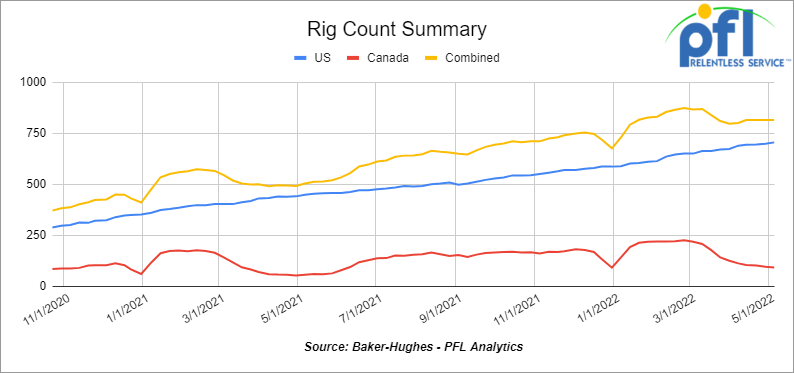
A few things we are keeping an eye on:
Petroleum Carloads
The four-week rolling average of petroleum carloads carried on the six largest North American railroads rose to 23,468 from 23,293, which is a gain of +175 rail cars week-over-week. Canadian volumes were mixed: CP shipments were down by 4.2% while CN volumes were up by 14.5%. U.S. volumes were down across the board with the BN having the largest percentage decrease (down by 17.7%).
New Railcar orders are up as backlog increases
The Railway Supply Institute (RSI) just reported industry railcar statistics for the first quarter of 2022. To summarize, orders were 13,000 units versus 13,500 in the fourth quarter of 2021. Backlog increased 7.5% sequentially to 46,200 units. Non-tank orders were down 3,000 units and tank car orders were up 2,500 units. These orders remain above replacement levels.
The U.S. Department of Energy (“DOE”) announced a SPR Buyback Plan.
On Thursday of last week, the DOE said that it will initiate a transparent, competitive process to replenish U.S. emergency crude oil distributed to alleviate global supply disruptions caused by what it calls “Putin’s War.”
The buyback process will begin with a call for bids to repurchase a third of the 180 million emergency barrels released as part of a coordinated action with our international partners to provide a “wartime bridge supporting American consumers and the global economy in response to Vladimir Putin’s war of choice against Ukraine.” We thought the release from the SPR was for price control heading into the midterms! If we really want to increase supply we should open up the drilling taps everywhere, and become energy independent thus avoiding wars. Don’t know about you folks, but it is getting tiresome listening to finger-pointing. The call for bids will take place in the fall of 2022 to secure delivery in future years when prices are anticipated to be significantly lower than they are today, and will represent a first tranche of purchases to replenish the SPR, with more planned after these purchases are executed.
As part of this buyback plan, DOE intends to begin a rulemaking proceeding to consider broadening DOE’s buyback regulations to allow for a competitive, fixed-price bid process as an alternative to the index-pricing that is traditionally used. Now this makes sense, let’s hope we buy back cheaper than we sold and make the country back some money!
Some Key Economic Indicators
Purchasing Managers Index (“PMI”) – The PMI (which covers manufacturing) and the Services PMI (covering services) are both from the Institute for Supply Management. They are based on surveys of supply managers around the country. The surveys track the direction of changes in business activity. An index reading above 50% indicates expansion; below 50% means contraction. The more above or below 50, the faster the pace of change.
The PMI fell from 57.1% in March to 55.4% in April. That’s the 23rd straight month above 50% but is the lowest reading since September 2020. The new orders component of the PMI fell to 53.5% in April, down slightly from 53.8% in March. The Production subcomponent also fell slightly from 54.5% in March to 53.6% in April.
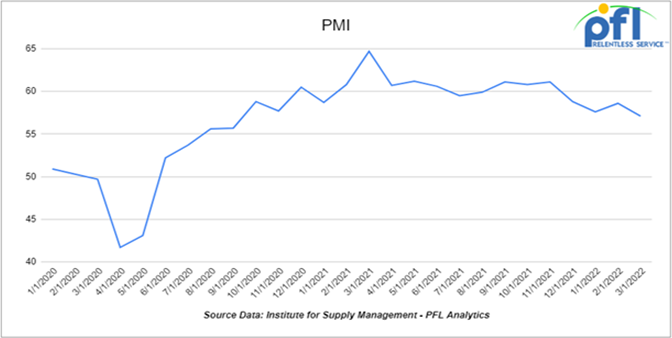
Based on preliminary data from the Federal Reserve, U.S. industrial output rose a preliminary and seasonally adjusted 0.9% in March 2022 from February 2022, matching the increase in February from January and just shy of the 1.0% increase in January from December. Those gains mean total industrial output in March 2022 was the highest on record, breaking the previous record set in August 2018. The Federal Reserve figures are subject to revision later this quarter.
Manufacturing output, which is around 75% of total output, rose a preliminary 0.9% in March and 1.2% in February. It remains well below its peak, which was in late 2007 and early 2008.
A 7.8% increase in auto output was the main factor behind March’s big gain in manufacturing output. Excluding autos, output rose 0.4% in March. Other industries of interest to railroads with output gains in March included nonmetallic minerals (up 3.0%), petroleum refineries (up 1.5%), and agricultural chemicals (up 1.1%). Output of railroad rolling stock fell 3.0% in March.
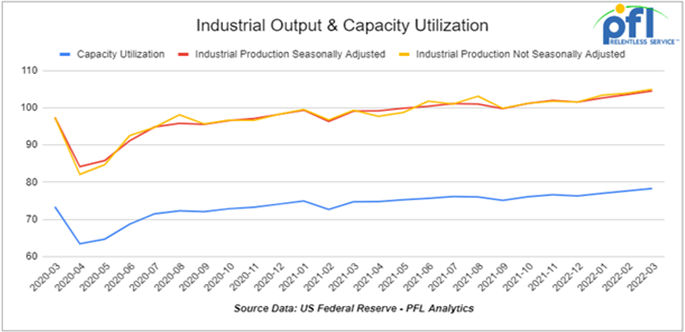
A preliminary 428,000 net new jobs were created in April 2022, matching the jobs created in March and the 12th straight month with job gains exceeding 400,000. Over the past year, 6.6 million net new jobs were created.
As of April, the economy has regained 20.8 million of the 22.0 million jobs lost in March and April 2020. The official unemployment rate in April remained at 3.6%, the same as March.
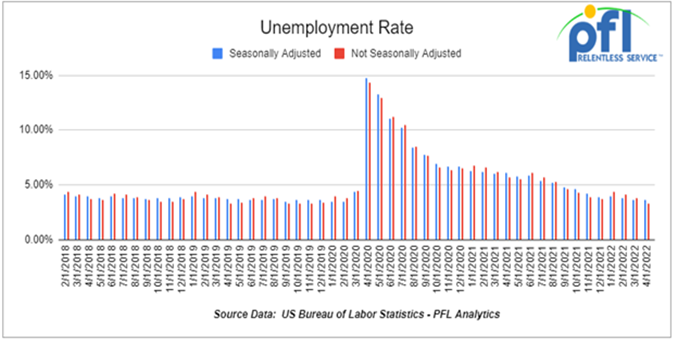
Not surprisingly the Conference Board’s index of consumer confidence fell from 107.6 in March to 107.3 in April. Consumer confidence has been trending down since mid-2021.
The University of Michigan’s index of consumer sentiment rose to 65.2 in April from 59.4 in March, but it remains far below where it was at this time last year and well below its peak in early 2020. The Michigan index, like the Conference Board index, has trended down over the past nine months.
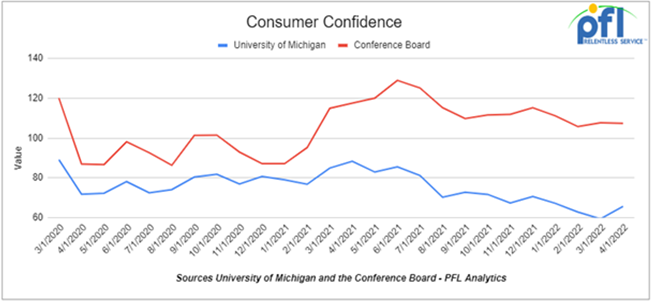
Total consumer spending not adjusted for inflation rose a seasonally adjusted 1.1% in March 2022 over February 2022, its third month-to-month gain in a row. In March, spending on services rose 1.1%, its biggest month-to-month gain in eight months. Spending on goods rose 1.2% in March, higher than its average over the past six months. Consumer spending on services today is close to twice as much as spending on goods.
Adjusted for inflation, total spending rose just 0.2% in March following a 0.1% gain in February.
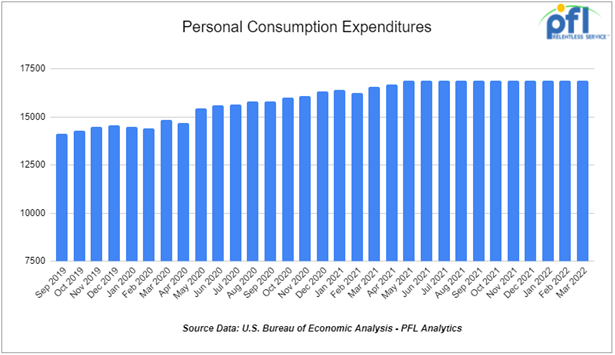
We have been extremely busy at PFL with return on lease programs involving rail car storage instead of returning cars to a shop. A quick turnaround is what we all want and need. Railcar storage in general has been extremely active. Please call PFL now at 239-390-2885 if you are looking for rail car storage, want to troubleshoot a return on lease scenario, or have storage availability. Whether you are a car owner, lessor or lessee, or even a class 1 that wants to help out a customer we are here to “help you help your customer!”
Leasing and Subleasing has been brisk as economic activity picks up. Inquiries have continued to be brisk and strong Call PFL Today for all your rail car needs 239-390-2885
PFL is seeking:
- 5, 29k Tank Cars needed in Texas off of the KCS for 5 years. Need to be lined.
- Up to 40 5500 Covered Gons 286 unlined CSX/NS preferred but will consider other
- 30 boxcars on UP or CP for 3 years to run from TX to Edmonton – negotiable
- 6-10 Open top 4200 gons for hauling scrap NS in Ohio for 1-3 years
- 100, 2480 CU-FT Ag Gons needed in Texas off of the UP for 1-3 Years.
- 50, 30K+ Tank cars are needed in several locations. Can take in various locations off various Class 1’s. Can have prior Ethanol heel or Gasoline heel.
- 300 5800 Covered hoppers needed for plastic – 5-year lease – negotiable
- 50 29K C&I Tanks for veg oil to purchase – Immediate need
- 15 5200-5500 PD hoppers in the west UP for 5 years for soda ash negotiable
- 30 5800 and 6250 covered gons for sale
- 50, 5800cuft or larger Covered Hopper for use in DDG needed in the Midwest for 3-4 years. Immediate need.
- 10-20 Covered hopper grain cars in the Midwest 5200-5500 2-3 years
- 20-30, 19K Tank Cars for Caustic Soda needed in Texas off of the UP or BN.
- 100 Moulton Sulfur cars for purchase – any location – negotiable
- 12 Plate F 286 GRL Boxcars 12’ plug doors Midwest preferred for a 1-year lease
- 30-50 Log Flats with stanchions 286K GRL in the midwest/east CSX NS 1-3 years negotiable
- 50 Ag Gons 2500-2800cuft 286k GRL in the east CSX for 5 years negotiable
- 25 Covered wood chip Gons 6000 CF 286 GRL any location for 1-3 years negotiable
- 25 Boxcars for paper 6000CF 286 GRL 1-3 years anywhere
- 100 15K Tanks 286 for Molten Sulfur in the Northeast CSX/NS for 6 months negotiable
- 100, 5800 Covered Hoppers 286 can be West or East for Plastic 3-5 years
- 70, 117R or J needed for Ethanol for 3 years. Can take in the South.
- 50, 6500+ cu-ft Mill Gon or Open Top Hopper for wood chips in the Southeast for 5 Years.
- 25 bulkhead flats 286 any class one for up to 5 years Negotiable
- 20, 19,000 Gal Stainless cars in Louisiana UP for nitric acid 1-3 years – Oct negotiable
- 10, 6,300CF or greater covered hoppers are needed in the Midwest.
- 2, 89’ Flatcars for purchase or lease – needed in TX off the BNSF
PFL is offering:
- Various tank cars for lease with dirty-to-dirty service including, nitric acid, gasoline, diesel, crude oil, Lease terms negotiable, clean service also available in various tanks and locations including Rs 111s, and Js – Selection is Dwindling. Call Today!
- 200 Clean C/I 25.5K 117J in Texas. Brand New Cars!
- 150 25.5 111’s in the Midwest for sale – Negotiable
- Up to 150 sand cars for sale at various locations and class ones – Great Price!
- 150 117R’s 31.8 clean for lease in Texas KCS – negotiable
- 31.8K Tank Cars last in Diesel. Dirty to dirty in Texas
- 200 117Js 29K OK and TX Clean and brand new – Lined- lease negotiable
- 100 117Rs dirty last in Gasoline in Texas for lease Negotiable
- 90 117Rs 30K located in Alberta CN or CP Refined Products Dirty – negotiable
- 99 340W Pressure Cars various locations Butane and Propane dirty negotiable
- 100-150 29K C/I 117J cars for lease. Dirty in Bakken crude and can be returned dirty.
- 100 29K C/I 1232 cars for lease. Dirty in Heavy Crude and can be returned dirty.
- 50 29K 117Js in Nebraska for sale or lease clean last in crude
- 100 117Rs 29K clean last used in crude Washington State – price negotiable sale or lease
- 100 111s of various volumes and locations last in fuel oil dirty price negotiable
- Various Hoppers for lease 3000-6250 CF 263 and 268 multiple locations negotiable
- 100 3200 Covered Hoppers for sale price negotiable
Call PFL today to discuss your needs and our availability and market reach. Whether you are looking to lease cars, lease out cars, buy cars or sell cars call PFL today at 239-390-2885
PFL offers turn-key solutions to maximize your profitability. Our goal is to provide a win/win scenario for all and we can handle virtually all of your railcar needs. Whether it’s loaded storage, empty storage, subleasing or leasing excess cars, filling orders for cars wanted, mobile railcar cleaning, blasting, mobile railcar repair, or scrapping at strategic partner sites, PFL will do its best to assist you. PFL also assists fleets and lessors with leases and sales and offers Total Fleet Evaluation Services. We will analyze your current leases, storage, and company objectives to draw up a plan of action. We will save Lessor and Lessee the headache and aggravation of navigating through this rapidly changing landscape.
PFL IS READY TO CLEAN CARS TODAY ON A MOBILE BASIS WE ARE CURRENTLY IN EAST TEXAS
Live Railcar Markets
| CAT | Type | Capacity | GRL | QTY | LOC | Class | Prev. Use | Clean | Offer | Note |
|---|
